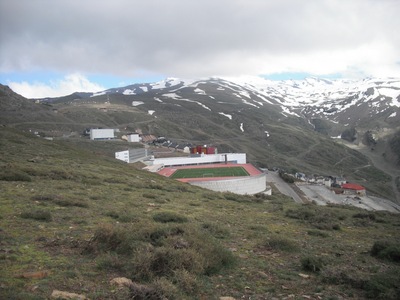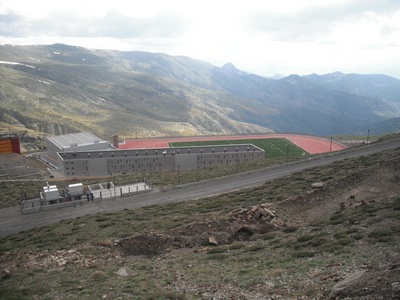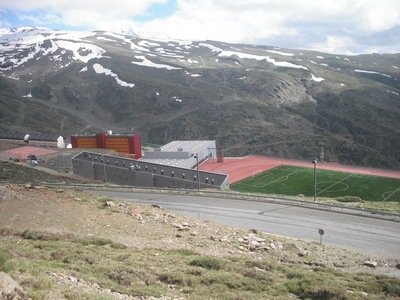When a person spends time at high altitude, that person’s body reacts to the lesser amount of oxygen in the air by increasing the number of red blood cells. These carry oxygen round the body, and if there are more of them, the body can process similar amounts of oxygen even though there is less of it available. If a person descends after spending days or weeks at high altitude, the higher number of red blood cells persists for a few days. In that period, the body is able to process much larger amounts of oxygen than is normal. This results in tremendous feelings of euphoria, and greater than normal athletic stamina. From personal experience, I can assure you that this feels wonderful. On one occasion, after descending several thousand metres in the Himalayas in several days, I felt like Superman. It was great. It was like being on the right drugs without actually being on drugs.
This effect can of course be duplicated at sea level. One way is to train in enclosed facilities with artificially lowered air pressure. Another, though, is medical. One can have one’s own blood removed from your body, the red blood cells filtered out, and these can be transfused back into your body in time for the athletic event. This is “blood doping”, and is much used in endurance sports, particularly cycling. It is generally considered to be cheating, but it is a very difficult form of cheating to detect. The fact that it is like being on drugs without the use of actual drugs perhaps gets to the core of the problem. Detecting the presence of drugs is relatively simple. Detecting the presence of the athlete’s own blood is simple too, but this doesn’t prove anything. As a consequence, athletes in affected sports are subjected to searches of their homes during the competition season in which inspectors look for medical equipment used in the necessary transfusions. (They also look for pharmaceutical supplies of the hormone erythropoietin, which stimulates production of red blood cells in the bone marrow).
Other tests for blood doping involve blood analysis, and involve such things as comparing the number of young red blood cells in a sample with the number of old blood cells, simply registering blood with an excessively high number of such cells as evidence of cheating. Plus they look for that hormone erythropoietin, for which it is apparently possible to tell the difference between the cloned and artificially produced version and the natural version produced in the athlete’s kidneys, although this distinction is sometimes controversial.
The trouble with tests of this kind is that they have difficulty distinguishing between people who are cheating (according to the rules) and people who simply have extreme and unusual physiology. To some extent, high level sport is all about identifying people with extreme and unusual physiology. The right kind of extreme and unusual physiology is known as “talent”. The aim of much performance enhancing technology is all about mimicking the extreme and unusual physiology that the finest athletes have naturally. Distinguishing between the naturally weird and the artificially weird by testing for weirdness is problematic.
And in the case of blood doping, we have a further problem. Blood can be doped naturally, simply by training at altitude. You cannot simply ban all athletes who live or train at altitude: that would be ‘discriminatory’. However, it leads to a situation where an athlete with a high red blood cell count due to altitude is a fine, well trained athlete and a role model for our children. One with a high red blood cell count due to a transfusion at sea level is a cheat and someone to be despised, even though the end result of both techniques are the same. (This makes me think of “organic” food, somehow. Food grown with nitrogen from natural fertilisers is good. Food grown with identical nitrogen from artificial fertilisers is bad).
Governments find it highly prestigious when national athletes win Olympic gold medals, and are often willing to spend money on elite athlete training programs. Two kinds of governments seem to do this. There are totalitarian regimes who wish to demonstrate that their system is superior by producing superior athletes. Classically, we are talking East Germany, the USSR, and more recently China. Such governments seem perfectly willing to break the rules if they think they can get away with it. More recently, though, we have freer, more democratic rich countries doing the same thing. As the state expands, development of the national Olympic team becomes part of its remit. Outright cheating has certainly occurred in such training programs too, but in a democracy it becomes a major scandal if you are caught. Therefore, government funded programs in democracies tend to prefer to remain within the (always very arbitrary) rules, but they will go as close to them as they can without actually breaking them.
If you are going to find a place to train at altitude, for fairly obvious reasons you want a place that is high but not too cold, so you are going to want it to be on a mountain not too close to the poles. You ideally want it to be on an isolated mountain rather than high up a mountain range, so athletes can regularly practice going from high altitude to low and vice versa. You are going to want it to be in an area where the other facilities of an advanced, high technology country are readily available – good hospitals and access to all kinds of medical professions, nice hotels, housing, and restaurants for associated officials, staff, and hangers on, etc etc etc. Basically, you want a high mountain in the desert in a rich country near a significant town.
Once you understand all this, what one finds clinging to the side of a mountain when one approaches the top of the Sierra Nevada in Andalucia in southern Spain (the southernmost high mountain in Europe) becomes perfectly logical: an athletic track and vaguely Orwellian looking training and accommodation centre for athletes.
A little googling indicates that it belongs to the vaguely Orwellian sounding Senior Sports Council of the Ministry of Education and Science of Spain. Amongst the benefits of training there, I find the euphemistically described erythropoietic stimulus, which is entirely different from blood doping. Obviously.
As I said, all perfectly logical. Perfectly.
Oh, who am I kidding? This is the oddest facility I have encountered since the time I went to Hitler’s holiday camp.
Hitler would have loved this, too.







Fascinating. And, I cannot believe I missed Hitler’s holiday camp when you first posted it – what a lovely place to spend a vacation!
BTW, the ‘erythropoietic stimulus’ link is broken, and I couldn’t find anything worthy on google, at least not at first attempt. No big deal though, you explained the general idea quite well.
“It was like being on the right drugs without actually being on drugs. ”
So, tell us about these “right” drugs.
Alisa: I’ve fixed the link.
Thanks Michael. Still, not nearly as appealing as the Hitler camp. Only the Germans know how to have real fun!
So, tell us about these “right” drugs.
Well basically Patrick, the illegal ones, cos if you think you are safe on the legal ones, you end up like Michael Jackson and Elvis Presley, dead. Or with no willy like the steroid fanciers.
“Governments find it highly prestigious when national athletes win Olympic gold medals, and are often willing to spend money on elite athlete training programs.”
Which is one reason why I not only detest the Olympic Games – but also the utterly remote “World Games”, which if you discount the politicians jazzing all over it, has an international following of about five.
The football World Cup (and more particularly the football governing bodies) is similarly detestable, but it does at least have the considerable grace of being a tournament for the world’s most popular sport – one in which the term “talent” is rightfully recognized as the application of tactical and strategic thought through physical skill rather than brute muscular performance.
OK, since no one else has done so let me ask the obvious question: since training at altitude is perfectly acceptable, as is training in special low-pressure chambers, why does it somehow become “wrong” when the identical result is achieved through some other approach? There are too many stupid rules.
One day they will have competitions where all this, and outright drug taking, is within the rules. An athlete will have behind him or her a crew of doctors and drug experts (wearing the logos of major drug companies) and it will be recognised that the athlete’s success is a team effort.
Yes, it is all somewhat artificial. Reminds me of our fiat currencies and other social juggling that tries to defy reality.
The whole obsession with team/ball sport is ridiculous in the first place but it is something to latch one’s identity and prestige onto, I suppose.
But as for the Spanish training centre, I would say they are sensibly utilising an asset.
Weird? Creepy?
Hack Green, eat your heart out.
Observe, for example, the US Olympic facility in Colorado Springs Colorado, at about 6300 ft (~2000 meters) altitude.